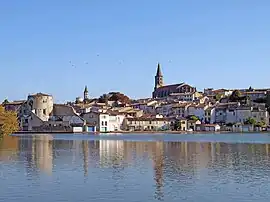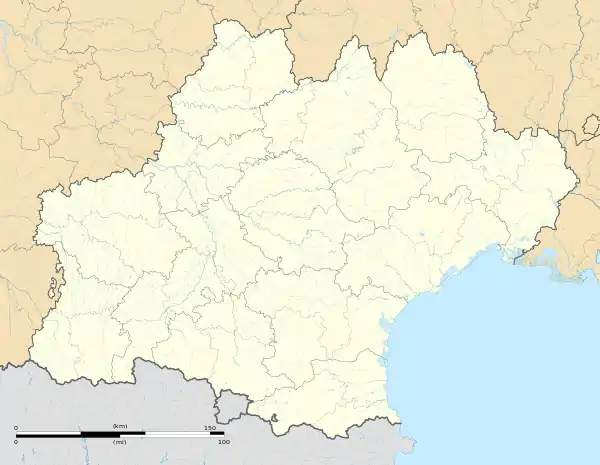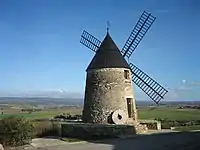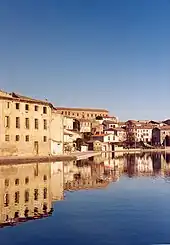Castelnaudary
Castelnaudary (French: [kastɛlnodɑʁi] ⓘ; Occitan: Castèlnòu d'Arri) is a commune in the Aude department in the Occitanie region of southern France. It is located in the former province of the Lauragais and famous for cassoulet of which it claims to be the world capital, and of which it is a major producer.
Castelnaudary | |
|---|---|
 A general view of Castelnaudary | |
 Coat of arms | |
Location of Castelnaudary | |
 Castelnaudary  Castelnaudary | |
| Coordinates: 43°19′09″N 1°57′16″E | |
| Country | France |
| Region | Occitania |
| Department | Aude |
| Arrondissement | Carcassonne |
| Canton | Le Bassin chaurien |
| Intercommunality | Castelnaudary Lauraguais Audois |
| Government | |
| • Mayor (2020–2026) | Patrick Maugard[1] (PS) |
| Area 1 | 47.72 km2 (18.42 sq mi) |
| Population | 12,467 |
| • Density | 260/km2 (680/sq mi) |
| Time zone | UTC+01:00 (CET) |
| • Summer (DST) | UTC+02:00 (CEST) |
| INSEE/Postal code | 11076 /11400 |
| Elevation | 145–215 m (476–705 ft) (avg. 165 m or 541 ft) |
| 1 French Land Register data, which excludes lakes, ponds, glaciers > 1 km2 (0.386 sq mi or 247 acres) and river estuaries. | |
Geography
Castelnaudary is a market town, and the capital of the territory of Lauragais. The town is located 50 kilometers (31 miles) southeast of Toulouse, about midway along the route from that city to the Mediterranean. This route has been used since at least Roman times, and today carries road, motorway (A61), rail and canal links. Castelnaudary is the main port of the Canal du Midi to which it owed a period of prosperity in the 17th century when agricultural and manufactured produce became easier to export. The Grand Bassin in the town is at 7 ha the largest open area of water in the canal, and is today its major pleasure port. Castelnaudary station has rail connections to Toulouse, Carcassonne and Narbonne.
History
Roman staging post
In Roman times the location of the town was a staging post on the Narbonne-Toulouse road, and called Sostomagus.[3]
Origin of the name
Castelnaudary comes from the Occitan Castèlnòu d'Arri — Latin translation Castellum Novum Arri — meaning "Arrius' new castle".
Major events
- 1103. First official mention of a settlement at Castelnaudary.
- 1211. During the Albigensian Crusade, Simon de Montfort, 5th Earl of Leicester is besieged in Castelnaudary by the Count of Toulouse and the Count of Foix.
- 1235. Arrival of the Papal inquisition whose initial attempts to identify and persecute Cathars were unsuccessful due to the solidarity of the townsfolk.
- 31 October 1355. During the 100 Years War, the town is sacked by the Black Prince who travelling from Bordeaux, ravaged the weaker towns of Gascony and then the Lauragais as far as Narbonne. The town was pillaged and the inhabitants massacred. The town's walls were not rebuilt until 10 years later.
- 1477. The town becomes the capital of the comté of Lauragais under Louis XI of France.
- 1632. The capture of Henri II de Montmorency just outside the town leads to his execution at Toulouse on the orders of Cardinal Richelieu.
- 15 May 1681. Commissioning of the Canal du Midi.
- 1754. Construction of L'Ile de la Cybèle.
- 1814. Marshal Soult withdraws to the town after the Battle of Toulouse before signing a final surrender at Naurouze.
Population
Its inhabitants are called Chauriens.
|
| ||||||||||||||||||||||||||||||||||||||||||||||||||||||||||||||||||||||||||||||||||||||||||||||||||||||||||||||||||
| Source: EHESS[4] and INSEE (1968-2017)[5] | |||||||||||||||||||||||||||||||||||||||||||||||||||||||||||||||||||||||||||||||||||||||||||||||||||||||||||||||||||
Sights
- L'Apothicairerie de l'Hôpital
- La Collégiale Saint-Michel
- Les Ecluses Saint-Roch
- Le Grand Bassin
- La Halle aux Grains
- L'Ile de la Cybèle.
- Le Moulin de Cugarel
- La Légion étrangère
- Le Présidial
- La Chapelle Notre-Dame de Pitié
 Moulin de Cugarel
Moulin de Cugarel Canal du Midi in Castelnaudary
Canal du Midi in Castelnaudary
Personalities
Castelnaudary was the birthplace of:
- Pierre de Castelnau d. 1208
- Pierre-Jean Fabre (1588-1658), physician to King Louis XIII
- Philippe de Rigaud Vaudreuil (1643–1725)
- Joseph Martin-Dauch (1741–1801), the only deputy from the Estates General of the Third Estate known to have signed as 'opposant' from taking the Tennis Court Oath, a major event of the French Revolution of 1789
- Jean François Aimé Dejean (1749-1824), army officer and minister of state in the service of the First French Republic and the First French Empire
- Antoine-François Andréossy (1761–1828)
- Antoine Marfan (1858–1942), pediatrician
- Georges Canguilhem (1904–1995), philosopher and member of the Académie française who specialized in the philosophy of science
Education
Military base
The 4th Foreign Regiment of the French Army has been stationed in Castelnaudary since 1976, and the base is open to the public on 30 April (Camerone Day) and at Christmas.
Cassoulet
Castelnaudary styles itself Capitale Mondiale du Cassoulet ("World Capital of Cassoulet") and the apocryphal legend of the genesis of this dish (originally called estofat) relates that it was first served to the defenders of the town during the siege of 1355.[6]
The town is home to the La Grande Confrérie du Cassoulet de Castelnaudary ("The Brotherhood of Castelnaudary's cassoulet"), an organization which seeks to promote and preserve the dish and its associated traditions. An annual festival celebrating cassoulet "fête du Cassoulet" is held in the last full week of August; the town center is thusly crowded with various versions of the traditional dish on that date.
The cassoulet variant favored in this town is based on the local haricot bean (which is the subject of a protected status application). It also includes goose or duck confit, pork, and Toulouse sausage.[6]
Traditional peasant versions of the recipe can take two days or more to prepare. The traditional cooking vessel is an eponymous earthenware pot called a "cassole."
Rick Stein featured the Castelnaudary cassoulet in an episode of Rick Stein's French Odyssey and his recipe can be found on the BBC Food website.[7]
References
- "Répertoire national des élus: les maires" (in French). data.gouv.fr, Plateforme ouverte des données publiques françaises. 13 September 2022.
- "Populations légales 2020". The National Institute of Statistics and Economic Studies. 29 December 2022.
- "Princeton encyclopedia of classical sites". Retrieved 11 February 2013.
- Des villages de Cassini aux communes d'aujourd'hui: Commune data sheet Castelnaudary, EHESS (in French).
- Population en historique depuis 1968, INSEE
- "Cassoulet History from the Mairie of Castelnaudary". Mairie de Castelnaudary. Archived from the original on 16 June 2012. Retrieved 26 June 2012.
- Stein, Rick. "Cassoulet". BBC Food. Archived from the original on 16 January 2008. Retrieved 26 June 2012.
- Catlos, Brian (2004). The Rough Guide to Languedoc and Roussillon. Rough Guides. pp. 107–110. ISBN 1-84353-244-1.
- André, Jacques (2003). Guide du Canal du Midi. Vert-Azur. pp. 107–113. ISBN 2-911793-01-3.
External links
- Castelnaudary (in French)
- Castelnaudary Tourisme (in French)